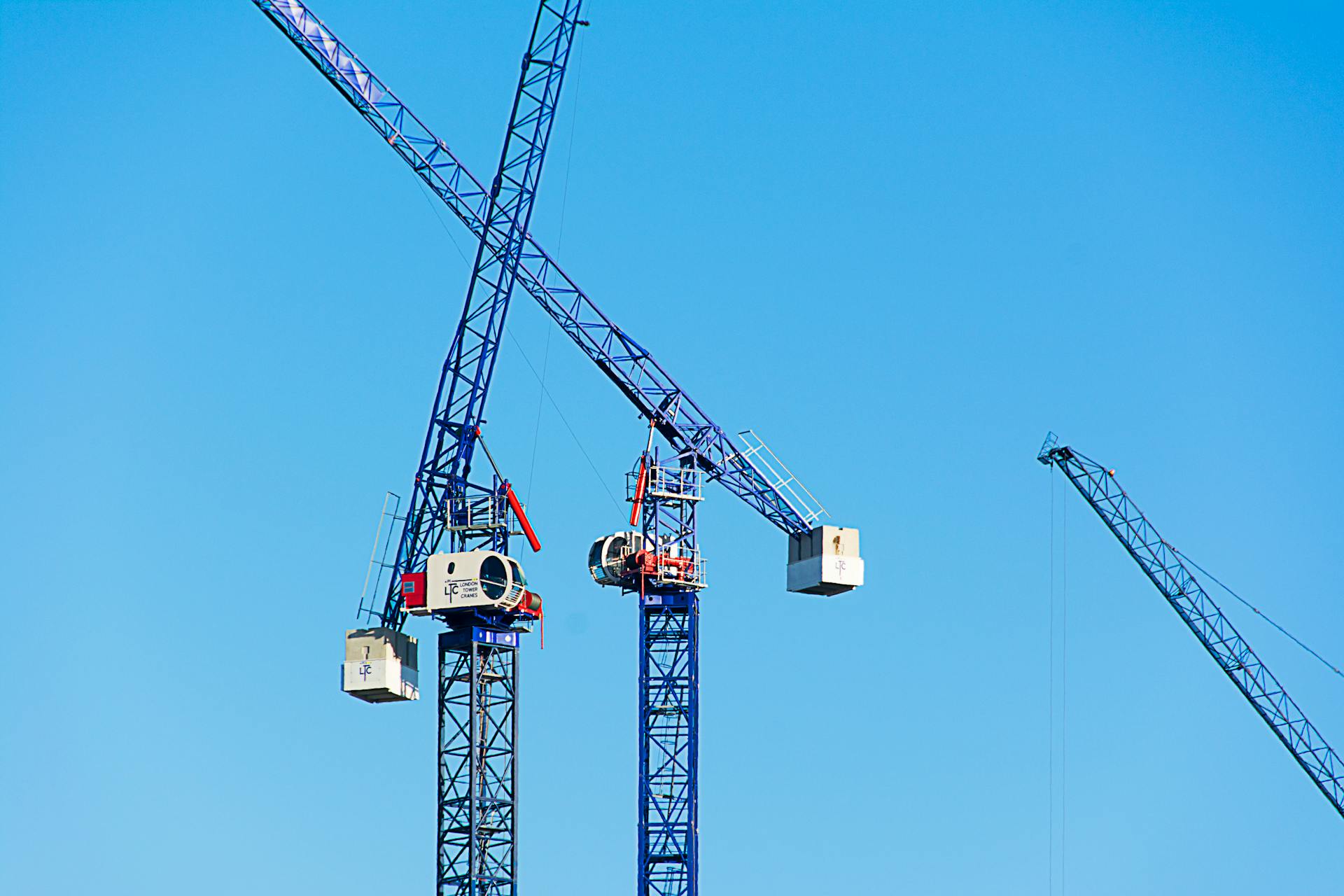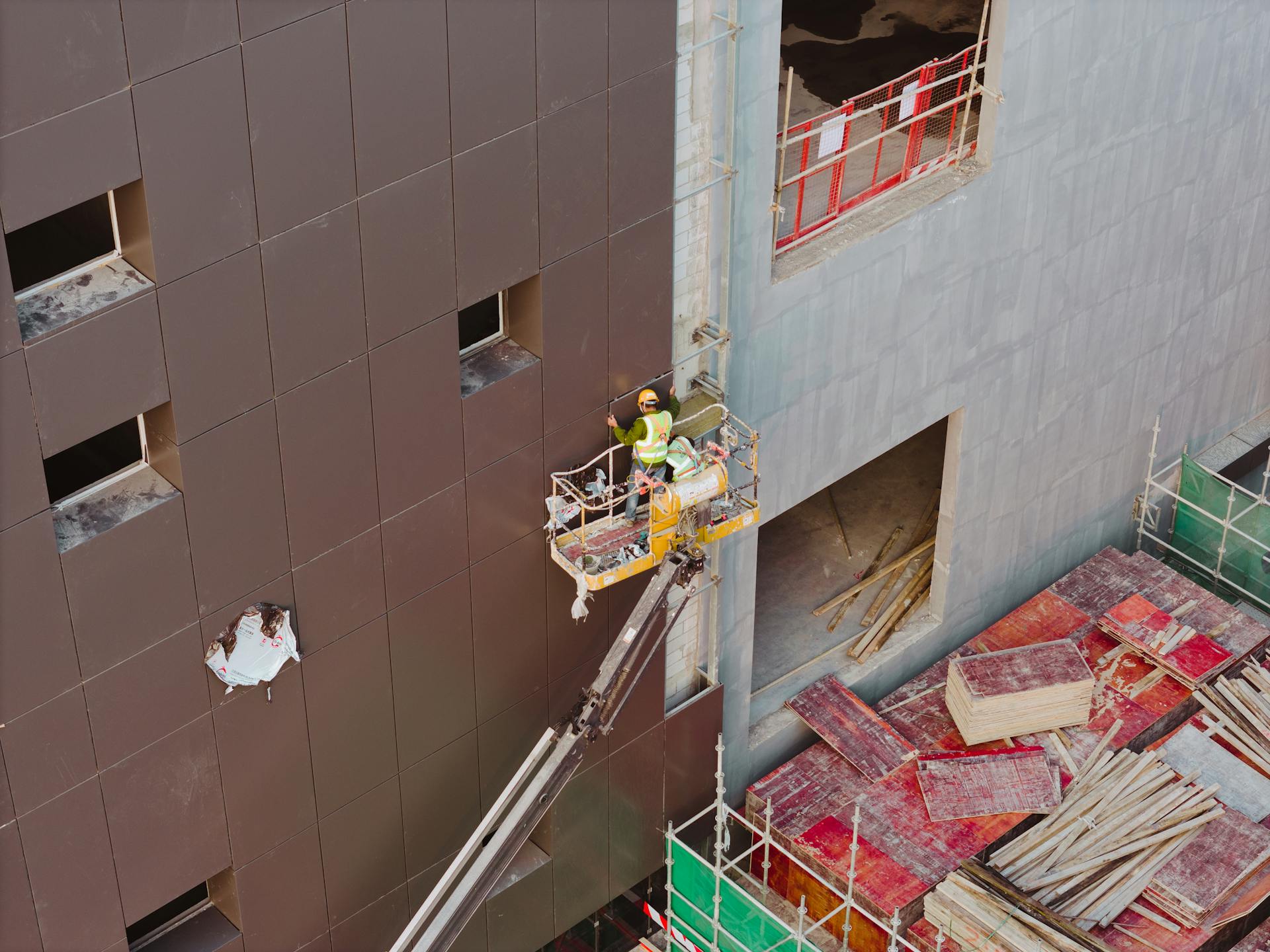
Construction sites can be intimidating, especially with all the heavy equipment buzzing around. Excavators are a common sight, used for digging and moving large amounts of soil, with some models capable of lifting over 50 tons.
Backhoes are versatile machines that can perform multiple tasks, including digging, lifting, and moving materials. They're often used for site preparation and excavation.
Cranes are tall machines that lift and move heavy loads with precision, typically used for construction and heavy lifting tasks. Some cranes can lift loads up to 200 tons.
Bulldozers are powerful machines that push and move large amounts of soil, often used for grading and clearing land.
Types of Construction Equipment
Excavators are large construction equipment that can be driven by tracks or wheels, but tracks are more standard. They have a long bucket arm attached to a pivoting cab that can rotate a full 360 degrees.
Excavators are highly versatile and can be fitted with special attachments for specialty jobs. The most common uses for an excavator include material handling, excavating trenches, holes, and foundations, and demolition.
Some common types of heavy construction equipment include articulated dump trucks, large dozers, large excavators, and large wheel loaders.
Here's a list of the most common uses for an excavator:
- Material handling
- Excavating trenches, holes, and foundations
- Brush cutting with hydraulic attachments
- Demolition
- Rough grading
- Heavy lifting and pipe installation
- Mining
- River dredging
Bulldozers
Bulldozers are among the most important pieces of heavy construction equipment. They're known for their strong power and versatility, making them ideal for a variety of tasks, from clearing large areas of land to leveling soil and removing debris.
Their distinctive feature is the large metal blade at the front, which pushes and distributes earth, preparing construction sites and roadwork. Bulldozers are also fitted with tracks, which provide stability and traction on rugged terrain.
The wide tracks distribute the bulldozer's weight over a large area, preventing it from sinking into sandy or muddy ground. This makes bulldozers one of the best types of heavy construction machinery for large-scale projects that demand mobile, powerful, and stable earth-moving equipment.
Some bulldozers come with a ripper on the back, which helps break up hard materials like asphalt or compacted soil. This attachment is particularly useful for projects that require excavation and grading.
Bulldozers are often paired with other heavy construction site equipment, making them a crucial part of any construction team. They're commonly used for clearing waste or vegetation before digging a foundation for a building.
Here are some common uses for bulldozers:
- Clearing large areas of land
- Leveling soil
- Removing debris
- Preparing construction sites
- Roadwork
Wheel Loaders
Wheel loaders are powerful and versatile machines commonly found on construction sites. They are equipped with a large bucket that can lift materials such as rubble, gravel, soil, debris, and dirt, perfect for loading into trucks for transport around the job site.
These machines are available in mini, compact, and large versions, allowing for a diverse range of work. They feature an articulating body and wheels, which provide a tight turning radius and exceptional maneuverability.
Wheel loaders are beneficial not only for site preparation, but also for clean-up operations after project completion. Their versatility makes them invaluable for maintaining workflow and productivity throughout the construction process.
Some key features of wheel loaders include:
- Large bucket capacity, typically storing around 3 to 6 m³
- Articulating body and wheels for tight turning radius and maneuverability
- Ability to operate over different terrains without damaging finished surfaces
Their design allows them to move faster and with greater mobility than bulldozers, which typically move on tracks.
Equipment for Every Task
Excavators are highly versatile and can be fitted with special attachments for specialty jobs, making them a crucial piece of equipment for various tasks.
Excavators are used for material handling, excavating trenches, holes, and foundations, brush cutting with hydraulic attachments, demolition, rough grading, heavy lifting, and pipe installation, among other tasks.
Whether you're working on a small project or a large-scale venture, there's an excavator that can handle the job.
Some of the most common uses for excavators include:
- Material handling
- Excavating trenches, holes, and foundations
- Brush cutting with hydraulic attachments
- Demolition
- Rough grading
- Heavy lifting and pipe installation
- Mining
- River dredging
Bulldozers are another essential piece of heavy construction equipment, known for their strong power and versatility, making them ideal for preparing construction sites and roadwork.
Their distinctive feature is their tracks, which provide stability and traction on rugged terrain, preventing them from sinking into sandy or muddy ground.
Bulldozers can also be fitted with a ripper on the back, which helps break up hard materials like asphalt or compacted soil.
Heavy construction equipment like excavators and bulldozers play a crucial role in completing large-scale projects efficiently and safely.
Understanding the capabilities of these machines and how to use them is essential for success in the construction industry.
Heavy Equipment Categories
Heavy equipment comes in various categories, each designed for specific tasks. Excavators are one of the most versatile machines, capable of digging trenches, holes, and foundations, as well as handling materials and demolition.
Excavators can be driven by tracks or wheels, but tracks are more standard, offering better stability and traction on uneven terrain. They have a long bucket arm attached to a pivoting cab that can rotate a full 360 degrees, providing the operator with excellent visibility of the site.
Some common types of heavy equipment include articulated dump trucks, large dozers, large excavators, and large wheel loaders. These machines are designed for heavy-duty tasks such as hauling, grading, and lifting heavy materials.
Here are some examples of heavy equipment used in construction:
- Articulated Dump Trucks
- Large Dozers
- Large Excavators
- Large Wheel Loaders
Backhoe Loaders
Backhoe loaders are versatile machines that consist of a tractor-like unit with a loader-style shovel on the front and a backhoe on the back. They are ideal for loading and carrying materials, while the rear backhoe is perfect for digging. Backhoe loaders perform numerous construction tasks, from excavating trenches and breaking asphalt to paving roads and moving dirt.
Recommended read: Skip Loader vs Backhoe
Their relatively small size allows them to operate in tight spaces where using multiple large machines would be impractical. This makes them particularly useful on sites where space is at a premium and versatility is required.
Backhoe loaders can be used for a wide variety of heavy construction projects, including excavation, demolition, and material handling. They are also beneficial for clean-up operations after project completion.
Here are some of the key benefits of backhoe loaders:
- Ideal for loading and carrying materials
- Perfect for digging and excavation
- Can perform numerous construction tasks
- Relatively small size allows for operation in tight spaces
- Versatile and can be used for a wide variety of projects
These machines are a popular choice for contractors and construction companies due to their versatility and ability to handle a range of tasks. With their loader-style shovel on the front and backhoe on the back, backhoe loaders are a valuable asset on any construction site.
Here's an interesting read: Tractor Loader and Backhoe
Motor Graders
Motor graders are construction vehicles used primarily to maintain unpaved roads and establish final grades on projects.
They excel at creating flat surfaces by spreading dirt and removing debris, ensuring the ground is perfectly prepared for the subsequent stages of construction. These vehicles feature machine control and guidance systems that enhance precision to within plus or minus a quarter of an inch.
Motor graders can also be used to fine-grade dirt or gravel roads, or to prepare the road base course before placing asphalt. They have a long adjustable blade that can be adjusted to meet certain angles to create a flat surface.
In addition to their precision and efficiency, motor graders are also equipped with auto-shift and auto-articulation technologies, simplifying operations for heavy equipment operators.
Trenchers
Trenchers are specialized pieces of equipment engineered to cut precise trenches into the earth, essential for installing pipes, cables, or drainage systems.
They come in many different types and sizes, from small walk-behind models to large ride-on types designed for more substantial projects.
Trenchers can quickly carve uniform trenches, reducing manual labor and time on site.
The key advantage of trenchers is their ability to easily slice through soil and tougher materials using a chain that resembles a giant chainsaw or a metal wheel adorned with cutting teeth.
Trenchers are invaluable tools in both the construction and utility industries, perfect for projects that demand ground excavation with minimal site disturbance.
They can cut into asphalt pavement and other hard surfaces, making them a versatile addition to any heavy equipment fleet.
A different take: Different Types of Cranes Machines
Tower Crane
Tower cranes are a crucial piece of equipment for construction projects, especially when building tall structures like skyscrapers.
A typical tower crane can lift up to 18 tons of weight, thanks to its robust structure.
They can reach a height of 265 ft, which is impressive, and as the height increases, the crane's foundation needs to be heavier to support it.
Tower cranes can move loads in a radius of 220 ft, making them ideal for covering the entire construction area.
Construction companies choose tower cranes based on the scope of the construction site, the required weight capacity for materials, and the height of the planned structure.
Here are the key factors to consider when selecting a tower crane:
- Scope of the construction site
- Required weight capacity for materials
- Height of the planned structure
Forklifts
Forklifts are vital supporting vehicles on construction sites, used to transport heavy materials in a safe and fast manner.
Contractors rely on forklifts to handle interior construction materials like wood, tiles, and bricks, which are often delivered in pallets.
Forklifts quickly pick up pallets and move them across paved surfaces, making them an ideal machinery for construction sites.
Rough-terrain forklifts are equipped with pneumatic tires that enable superior traction in off-road conditions, allowing them to move over rocks and maintain stability while carrying the load.
These vehicles can lift heavier objects, with load capacities ranging from one to 20 tons, depending on the specific model.
Vacuum Truck
Vacuum trucks are a type of heavy equipment used in situations that require precision removal of material without damaging surrounding cables and piping.
They are constructed with high-pressure vacuum and water jets that loosen and precisely draw material into the vacuum piping and into the holding tank.
Suction excavators offer greater safety in comparison to other types of excavators.
Recommended read: Full-function Mini Excavators
Concrete Mixers
Concrete mixers are a crucial piece of heavy construction machinery on sites where substantial volumes of concrete are required.
They accelerate construction processes by ensuring consistent and uniform concrete production.
These machines combine cement, sand, gravel, and water to form concrete, a necessary material for nearly all construction projects.
Their capacity to mix large volumes continuously makes them essential for large-scale construction projects.
Concrete mixers have a revolving drum that thoroughly combines aggregates, preventing material segregation and guaranteeing the concrete sets with uniform properties throughout.
This helps achieve optimal strength and durability in the finished product.
15 Construction Names You Should Know
Let's take a look at some construction names you should know.
Caterpillar is a well-known brand in the construction industry, known for its heavy machinery such as the 140M excavator.
The 140M excavator is a large machine, weighing over 80 tons.
Komatsu is another prominent brand in the construction industry, offering a range of heavy equipment including the PC200 excavator.
The PC200 excavator is a versatile machine, used for various tasks such as digging and lifting.
Deere is a leading manufacturer of heavy equipment, producing machines like the 320 excavator.
The 320 excavator is a popular choice among construction workers due to its reliability and performance.
Hitachi is a Japanese company that produces a range of heavy equipment, including the ZX200 excavator.
The ZX200 excavator is known for its high efficiency and low operating costs.
John Deere is also known for its skid-steer loaders, such as the 317G.
The 317G skid-steer loader is a compact machine, ideal for working in tight spaces.
Case is a well-established brand in the construction industry, offering a range of heavy equipment including the CX220 excavator.
The CX220 excavator is a powerful machine, used for heavy-duty tasks such as excavation and demolition.
Volvo is a Swedish company that produces a range of heavy equipment, including the EC220 excavator.
The EC220 excavator is a reliable machine, known for its durability and performance.
Bobcat is a popular brand in the construction industry, offering a range of compact machines such as the E10 excavator.
The E10 excavator is a lightweight machine, ideal for small-scale construction projects.
Here's an interesting read: Yanmar Compact Excavator
Doosan is a South Korean company that produces a range of heavy equipment, including the DX160 excavator.
The DX160 excavator is a versatile machine, used for various tasks such as digging and lifting.
Hyundai is a well-known brand in the construction industry, offering a range of heavy equipment including the R290LC-9 excavator.
The R290LC-9 excavator is a powerful machine, used for heavy-duty tasks such as excavation and demolition.
JCB is a UK-based company that produces a range of heavy equipment, including the JS200 excavator.
The JS200 excavator is a reliable machine, known for its durability and performance.
Kobelco is a Japanese company that produces a range of heavy equipment, including the SK210 excavator.
The SK210 excavator is a versatile machine, used for various tasks such as digging and lifting.
Specialized Construction Equipment
Excavators are highly versatile and can be fitted with special attachments for specialty jobs. They're used for material handling, excavating trenches, holes, and foundations, brush cutting with hydraulic attachments, demolition, rough grading, heavy lifting, and pipe installation.
Excavators come in different types and sizes, making them adaptable to a broad range of tasks and project conditions. They're available with tracks or wheels, with tracks being more standard.
These machines are designed to handle specific tasks, such as digging, demolition, and material handling. They can be fitted with attachments like breakers and augers, extending their capabilities to include concrete breaking and drilling.
Some common uses for excavators include:
- Material handling
- Excavating trenches, holes, and foundations
- Brush cutting with hydraulic attachments
- Demolition
- Rough grading
- Heavy lifting and pipe installation
- Mining
- River dredging
Scrapers
Scrapers are large heavy equipment designed for open areas where they can run at high speeds for cut and fill operations.
They're used primarily for digging and leveling large areas of land, making them a crucial tool on many construction sites.
A scraper's primary function is to move dirt and aggregates quickly around a construction site.
Soil Compactor
Soil compactors are heavy construction equipment designed to apply downward pressure on materials such as dirt, soil, or gravel.
They help to compress the ground and eliminate air pockets, which is essential for a stable and strong foundation.

The type of compactor you're going to use on a job depends on the terrain of the construction yard.
Contractors typically use soil compactors with a plate attachment and spiked wheels for landfill sites with granular soil.
Soil compactors with drums are ideal for construction terrain consisting of cohesive soil, like silt or clay, as the drum flattens the ground and removes the excessive air.
Inadequate soil compaction can lead to issues like foundation erosion, slab cracks, and pipe leakage or breaks.
Soil compactors greatly improve the stability and strength of the ground's surface, making it capable of supporting heavy loads and enduring long-term use.
The smallest piece of heavy equipment on the list is often a soil compactor, but don't let its size fool you - it's a crucial tool for any construction project.
Pavers
Pavers are essential heavy equipment for residential and road construction, capable of laying asphalt flat on the surface and providing minor ground compaction.
Their distinctive features include a feeding bucket that's continuously loaded with asphalt as the paver moves forward, and a paver screed at the front that disperses the asphalt mass evenly.
Modern pavers can increase the width of the screed to cover larger areas, and some can even monitor the paver's fuel consumption.
To achieve effective performance, pavers need to maintain a consistent speed and supply of materials, which is supported by other heavy equipment on the construction site, such as dump trucks loading their feeding buckets and drum rollers compacting the surface.
Contractors often use pavers in combination with other heavy equipment to create a smooth paved road, making them a crucial part of road construction projects.
A unique perspective: Road Grader
Long Reach
Long reach excavators can be either tracked or wheeled excavators, allowing them to have an increased ability to reach further distances and perform jobs that other types of excavators cannot.
These machines are ideally suited for tasks such as dredging in water, industrial demolition projects, landscaping uneven terrain, harbor construction, large underwater digging projects, and any task where a standard boom/stick assembly is not efficient or practical.
They can extend the reach up to 100 feet, which is 2X times greater than standard reach excavators that can only reach up to 40 feet.
Financing these long reach attachments is typically quite simple, with options available for most models.
Knuckle Boom
The knuckle boom excavator is a variation of the standard excavator with an extra joint on the boom/stick assembly, allowing the stick and bucket to rotate using hydraulic power mechanisms from side to side.
This extra maneuverability makes the knuckle boom excavator beneficial for working in tight spaces and excavating around obstacles. Excavators, including the knuckle boom type, are primarily used for moving large amounts of soil and gravel.
With the ability to rotate the stick and bucket, knuckle boom excavators can be greatly beneficial in the right situations, making them a valuable asset on construction sites.
You might like: Knuckle Boom Log Loader
Amphibious
Amphibious excavators are specially designed for use in waterways, featuring an amphibious undercarriage, sealed pontoons, and a buoyancy tank that allows them to float on the surface of the water.
They're used to perform dredging, which is the removal and transport of sediment to a location away from the existing waterway. This helps prevent sedimentation from filling harbors and rivers, interfering with cargo vessel passage.
These excavators are also used for controlling vegetation and installing underwater cables and piping.
Spider or Walking Machine
Spider or Walking Machine excavators are one of the most unique and impressive-looking types of excavators, designed with spider-like legs that can operate independently.
These machines are ideal for forestry due to the steep cliff faces and challenging terrain.
The legs of a Spider excavator can be fixed or telescoping, allowing the wheels at each end to be located on secure footing, whether it be angular sides of gullies, cliff ledges, or anywhere else solid footing is required.
They're considered the mountain goats of the machine world, capable of maneuvering on extremely steep hillsides and the most challenging terrains.
The cab of a Spider excavator sits on a rotating platform that can rotate 360 degrees, providing a clear view of the surroundings.
The boom/stick/bucket assembly is located at the front of the excavator, allowing for safe and effective excavation in tight spaces.
Not seen at many construction sites, Spider excavators are a specialized tool that requires specific expertise and conditions to operate effectively.
Cold Planers
Cold Planers are required for heavy construction projects that involve the removal and resurfacing of asphalt and concrete surfaces.
They come in various sizes, from smaller units used for minor repairs and tight spaces to larger models that can handle extensive roadwork projects.
A powerful milling drum on these machines strips away old layers of pavement, ensuring a smooth surface for new applications.
These machines feature a water system to control dust generated during milling, maintaining a clean and safe work environment.
Cold Planers are used for several purposes, including recycling asphalt for new roads, creating rumble strips along highways, and repairing existing damage.
Smoothing land before paving with a Cold Planer can minimize future potholes or cracks.
Pile Drivers
Pile Drivers are used in the construction of deep foundations, providing the necessary support for large structures.
These machines are able to penetrate well below the surface, transferring the structure's loads to the more stable soil or rock found below less stable upper layers.
Pile drivers work by driving piles—long, heavy beams of wood, steel, or concrete—deep into the soil using a heavy weight or hammer that is dropped repeatedly onto the pile.
This process helps to provide a stable base for the construction of buildings, bridges, and other infrastructure, and is essential in areas where the surface soil can’t support heavy loads on its own.
By creating a deep and sturdy foundation, pile drivers prevent settling and ensure the stability and safety of structures for years to come.
For more insights, see: Pile Driver Machine
Frequently Asked Questions
What is the biggest construction machine?
The largest construction machine is a hydraulic excavator manufactured in China, weighing 673 metric tons. Powered by two massive 50L Cummins diesel engines, it's a behemoth of engineering and construction capabilities.
What machine is used most in construction?
Wheel loaders are the most commonly used machine in construction, often found on various sites across the country due to their versatility and efficiency. They are a popular choice among construction professionals for their ability to handle a wide range of tasks.
What is the big machine on a construction site?
The big machine on a construction site is an excavator, a large machine used for digging and earthmoving. It typically consists of a bucket, arm, tracks, and rotating cab.
Sources
- https://www.liveabout.com/must-have-earth-moving-construction-heavy-equipment-844586
- https://gocodes.com/heavy-equipment-list/
- https://hawkexcavator.com/specs-brochures/excavator-types-101/
- https://www.deere.com/en/heavy-equipment/
- https://www.tcli.com/blog/15-types-of-heavy-construction-equipment-used-in-construction
Featured Images: pexels.com


